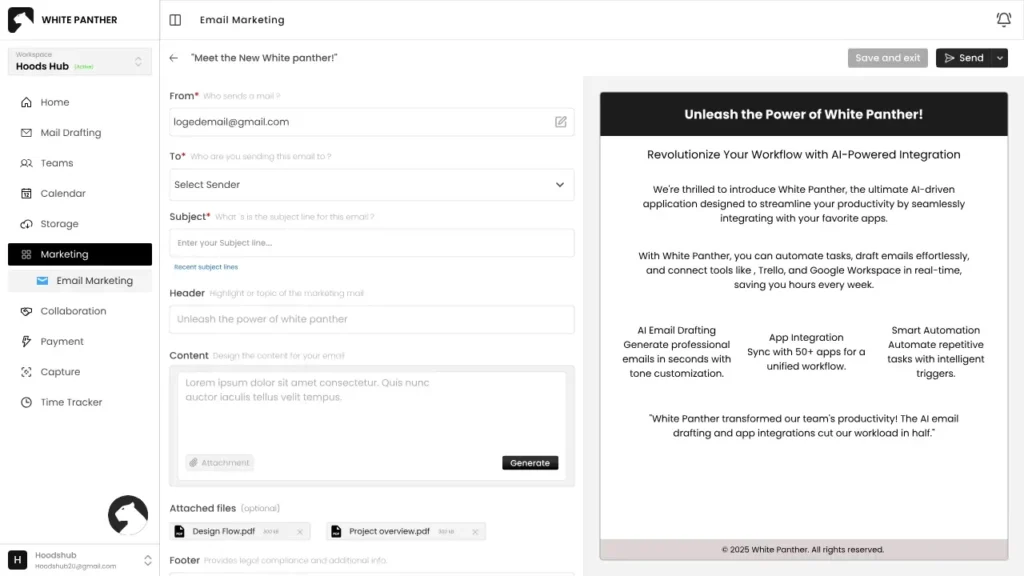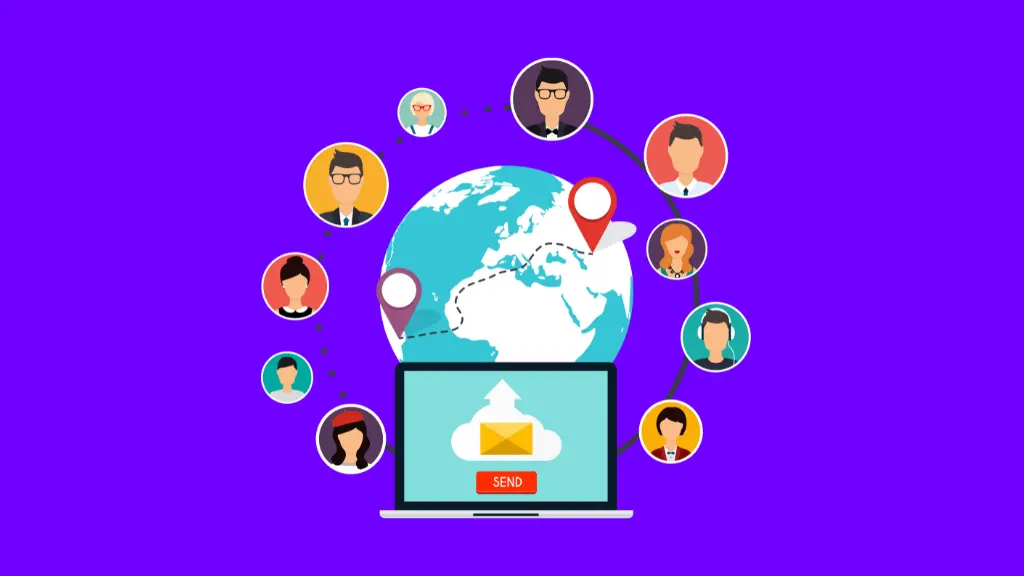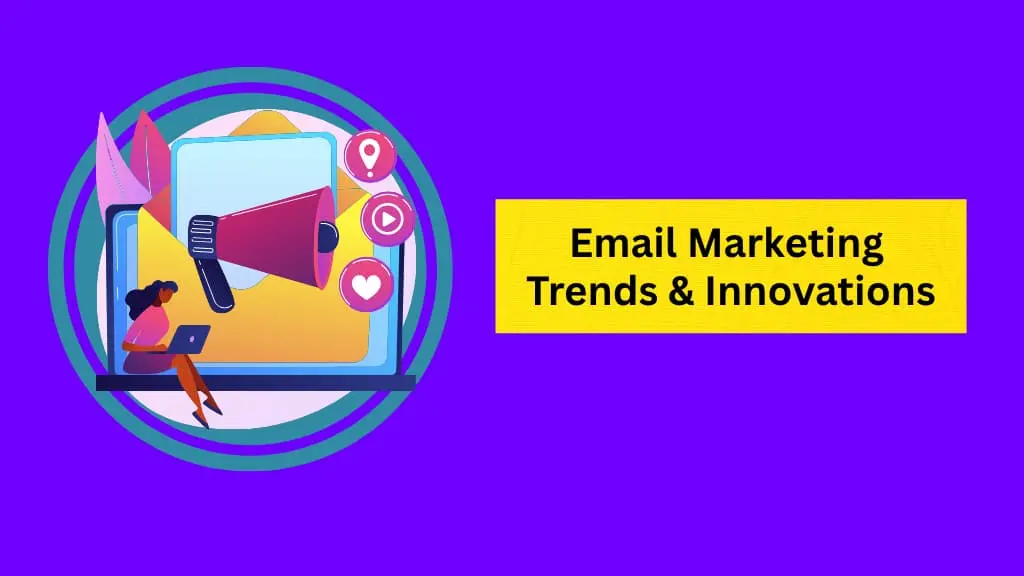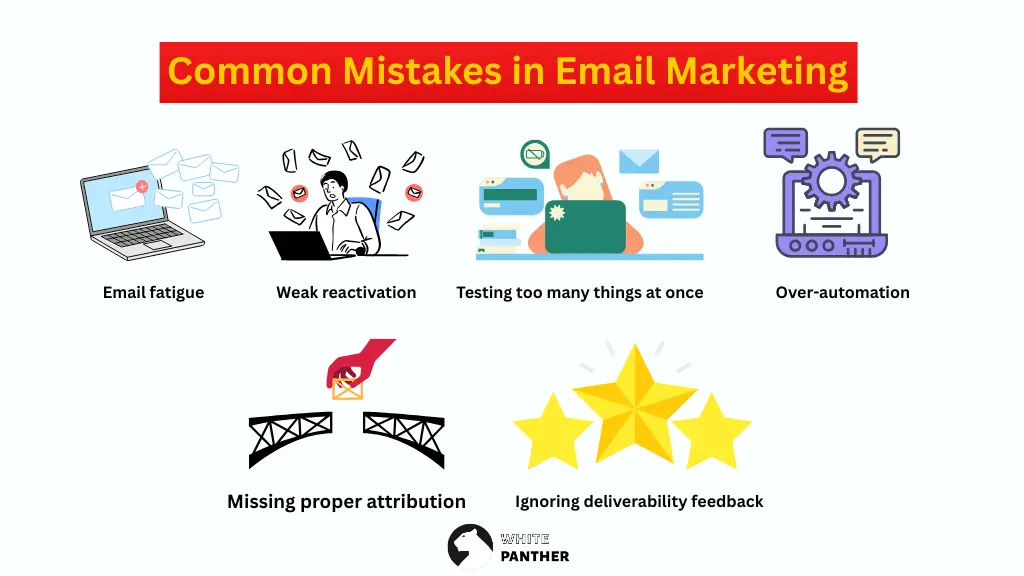Email marketing is not “dead”, far from it.
But the rules have changed:
With every business focusing on email marketing, now the user’s inboxes are saturated, privacy norms are changing, and user expectations are rising too.
So, to win now, you must think of email as a dynamic and adaptive dialogue and not just as a broadcast channel.
We went on the internet to search for the guide that can really help us, but most guides offered these details
- What is email marketing?
- What are the benefits of email marketing?
- What are the best email marketing tools?
- Tips and tricks to optimize your email marketing campaigns.
To be very honest, we found most of them to be very generic; this information is something we all know, and it was very generic. This didn’t fulfil the purpose of the email marketing guide.
So, we have created an email marketing guide with four foundational pillars of moder, high impact email strategies, methods to implement them, and how emerging technologies can refine your email performance.
Let’s start with what are the four pillars of advanced email marketing.
The Four Pillars of Advanced Email Marketing
Here are the four deep, structural pillars you must build your email marketing on:
- Permission & Trust Architecture
- Deliverability & Inbox Placement Intelligence
- Behavioral-Driven Content & Journey Orchestration
- Learning, Attribution & Predictive Optimization
Each pillar is very important for every campaign.
If you skip one, you will see the impact of the results.

1. Permission & Trust Architecture
Before you worry about opening or clicking, you need a solid foundation.
Ask why someone is in your inbox and how much trust you have earned.
Opt-in Engineering & Progressive Profiling
- Instead of just showing generic “subscribe to newsletter” popups, create micro-commitments: let users give minimal data at first like email + one interest and then gradually expand (name, preferences, demographic) via progressive profiling in subsequent interactions.
- Use contextual triggers: for example, when a visitor lingers on a content page, show a “Get in-depth version via email” form.
- Test multi-step forms (first “want updates?” then “which topics interest you most?”) rather than long forms upfront.
Privacy & Permission Transparency
- Be explicit about frequency, content type, and benefits at the opt-in stage. It helps reduce unsubscribe later.
- Provide clear and simple unsubscribe or preference-setting mechanisms in every email.
- Maintain data hygiene: remove inactive email addresses, respect to bounce codes, monitor spam complaints and remove unsubscribers from all the lists.
Internal Permission Layers
Not all email contacts are equal. So, you will have to internally classify them into different permission tiers.
| Tier | Definition | Strategy |
| Full Permission | Actively engaged users who open/click often | Eligible for high-intensity campaigns and cross-sell offers |
| Light Permission | Subscribers who open infrequently or only read certain topics | Send low-frequency, high-value content to rekindle trust |
| Passive / Dormant | No opens in 6–12 months | Use re-engagement series or remove gradually |
This segmentation by permission will help you preserve your sender’s reputation without overwhelming every user with the same number of emails.
2. Deliverability & Inbox Placement Intelligence
One of the most under-discussed but critical pillars: ensuring your emails actually land in the inbox (not spam).
Domain Authentication & Reputation
Before sending emails, make sure your domain is properly verified.
- Set up SPF, DKIM, and DMARC correctly: These settings prove that your emails are genuine. If they’re not configured properly, your emails might land in spam even if the content is great.
- Warm up your domain slowly: Start by sending smaller batches and increasing volume over time. Sending too many emails too soon can hurt your domain’s reputation.
- Keep checking your reputation: Use tools like Google Postmaster or Microsoft SNDS to monitor how email providers see your domain.

Engagement-Based Sending Logic
Email providers don’t just rely on your technical settings and reputation scores. They regularly check user engagement signals like opens, deletes without reading, etc.
You must have seen in Gmail, they ask for unsubscribe if you haven’t opened some email for a long time. So, optimizing engagement is equally important.
To optimize this,
- Start with your most active users: Send emails first to people who often open or click, then slowly include fewer active ones.
- Don’t send it to everyone at once: Target only those who are likely to be interested in that topic to reduce unsubscribes and spam complaints.
- Clean your list regularly: Pause or remove users who haven’t engaged for a long time.
Inbox Placement Testing & Shadow Headers
- Use seed lists across major email clients (Gmail, Outlook, Yahoo, Apple Mail) to test where your message lands (inbox, promotions tab, spam).
- Use tools that scan show header previews to see deliverability red flags (spam filter reasons, blocklists).
- Monitor bounce codes (both soft and hard) and act accordingly. For example, if a soft bounce repeats multiple times, treat it like a permanent bounce.
List Hygiene & Blocklist Defense
- Clean lists regularly (e.g. quarterly). Remove addresses that haven’t been engaged in 12 months.
- Monitor public blacklists and mail blocklist services; if your domain or IP appears, act fast (delist requests, reverse-engineer cause).
- Track and minimize spam complaints by improving subject lines, relevance, and ensuring you’re “From” address is easily recognizable.
3. Behavioral-Driven Content & Journey Orchestration
This is where your campaigns live. So instead of blasting static messages to everyone, your content and cadence should be driven by real user behaviour and context.
Journey Mapping by Behavior Triggers
- Identify key behavioral triggers like site visits, content downloads, cart abandonment, feature usage, and update the email journey based on this.
- Use event-based automation rather than a fixed calendar. For example, use events like cart abandonment, trial expiration, and reactivation to send appropriate emails.
- Treat each subscriber as having multiple micro-journeys (e.g. one for education, one for sale, one for retention) and send emails accordingly.
Dynamic & Adaptive Content Blocks
- Use dynamic content modules, swap in email sections based on recipient attributes (e.g. region, interest, past purchases).
- Use choice-based bifurcation (e.g. “click which topic you prefer” to dynamically send future content based on interest).
- Incorporate real-time data feeds (stock status, price changes, countdown timers) to make the email fresh and relevant.
Two-Way Communication & Feedback Loops
- Design emails that encourage responses (polls, surveys, reply-to prompts) and use these responses to segment users.
- Use microsurveys or mini quizzes inside emails to refine profile and content fitting.
- Encourage replies by acknowledging replies (auto-respond briefly or take human follow-up).
This turns email from monologue into conversation and helps enrich your data with relevant email addresses.
Cadence & Fatigue Control via Adaptive Frequency
- Rather than rigid sending schedules, implement adaptive email sequences. What we mean is that you can increase or reduce the email frequency based on engagement metrics like opens, clicks, or complaints. This will help you get better engagement and outcomes.
- For example, if a subscriber opens 3 of the last 5 emails, you may send more; if none, reduce frequency or pause.
- If you already know about major holidays, avoid sending your audience emails unless you have a big sale coming, or anything else that is specific to these holidays.
4. Learning, Attribution & Predictive Optimization
This pillar is about growing your campaigns and their outcomes. It’s about measuring, attributing, and optimizing your campaigns using advanced techniques.
Beyond Opens & Clicks, Advanced Metrics
Most businesses track traditional metrics like open rate, click-through rates, but they are just tips. Look deeper:
- Time Spent & Scroll Depth inside email (how long did someone read)
- Reply Rate or Forwarding Rate
- Conversion Path Attribution: Check which emails helped with conversion, and don’t just give credit to that one email, track all the previous emails to map out customer journey. click
- Revenue Per Email (RPE): average revenue generated divided by number of emails sent
- Lifetime Value (LTV) from Email Cohorts: measure how much value a cohort (by acquisition month) brings through email over time
- Inbox Placement Ratio: percent of emails landing in the primary inbox vs spam/promotions
A/B/C/N Testing & Controlled Experiments
- Don’t test multiple variables at once. Test only one variable per test. Be subject line, sender name, preheader, content blocks, CTA, layout, test only one parameter at once.
- Use multi-armed bandit testing; it’s a smarter version of A/B testing. Instead of splitting your audience evenly between all versions (A, B, C, etc.) until the test ends, send more emails that are performing better in real time.
- Use holdout control groups to measure lift in conversions: send to only 90%, hold out 10% and compare conversions over time.
Predictive Modeling & AI Assist
- Emails tools are getting smarter; you can use predictive algorithms to forecast open probability, click propensity, or churn risk.
- Use subject-line scoring models to predict and optimize open rates.
- Leverage prototype-based models (e.g. PROMINET) to generate interpretable content prototypes and improve response prediction.
- Use clustering models to detect hidden segments of users with similar behaviors or latent preferences.
- Use predictive insights to send emails when someone is most likely to open them, show content that matches their interests, and skip those who aren’t engaging anymore for better overall results.
Putting the Pillars into Practice: Implementation Guide
It’s one thing to understand pillars; it’s another way to implement them.
Phase 1: Audit and Gap Check
Begin by reviewing what you already have in place.
Check how people sign up for your emails and what kind of permissions you request.
Look at how your list is divided into active, inactive, or occasional readers.
Make sure your emails are reaching inboxes instead of spam folders.
List all your automated email journeys and identify what triggers each one.
Review your current performance metrics to understand what you track and what is missing.
Finally, rate each area from 0 to 5 to find out where you need the most improvement.
Phase 2: Set Up the Right Technology
- Fix technical essentials such as SPF, DKIM, and DMARC, so your domain is trusted.
- Connect your CRM or customer data platform to keep all behavior data in one place.
- Upgrade to an automation tool that allows real-time personalization and smart workflows.
- Add predictive or AI tools to help you send better content and score engagement more accurately.
Phase 3: Test with a Small Group
Before expanding fully, test new ideas with a small part of your audience, about 5 to 10 percent.
Keep a small control group that does not receive these emails to compare results.
Try a new campaign such as a reactivation or product recommendation flow and measure the real return on investment.
Phase 4: Roll Out and Scale
Once you see good results, expand gradually to your full audience.
Also monitor your performance carefully to avoid hurting your email reputation.
To further optimize it, add new journeys one at a time, and keep running one test per month.
Phase 5: Keep Improving and Reviewing
Regularly review everything, either weekly or monthly. It is to keep check of important metrics like revenue per email and inbox rate.
If you have resources, create a small team to review campaigns, approve changes, and maintain consistent branding across all campaigns.
It will help you stay relevant and effective in the long run.
Email Marketing Trends & Innovations to Watch
Staying updated with new trends helps your email strategy grow and stay effective. Here are some to keep an eye on:

Inbox Intelligence and AI Assistants
- AI tools and email apps can now filter or summarize messages, so your emails need to stand out clearly.
- Create content that reads naturally and connects with user interests to make sure it gets noticed.
Zero-Party and Implicit Data Signals
- Ask users to share their preferences directly through quizzes or surveys. This data helps personalize emails better.
- Track subtle actions like how long someone hovers a link or scrolls through an email to understand what interests them.
Dark Mode and Email Design Adaptation
- Many people read emails in dark mode, so check that your text, images, and colors look good on both light and dark backgrounds.
- Use flexible design styles that automatically adjust or stay readable no matter which mode the user chooses.
Omnichannel Communication and Channel Choice
- Think of email as one part of a larger system. If someone does not click your email, follow up with an SMS or app notification.
- Use tools that help you pick the best communication channel for each user based on their behavior.
Lifecycle AI and Smart Automation
- Future email systems will be able to adjust themselves automatically based on how users respond.
- These systems can change send times, content types, and audience groups in real time to keep performance high.
Pitfalls to Avoid & Common Mistakes in Email Marketing
Even the best email strategy can fail if you overlook a few key details. Here are some mistakes to watch out for:

- Over-automation without control: Don’t automate too many rules; it can lead to people getting too many emails and sometimes the wrong ones.
- Testing too many things at once: Test only one variable at once. If you test multiple times, you wouldn’t be able to track what’s working for you.
- Ignoring deliverability feedback: Take bounces, spam complaints, and poor domain health seriously as it can quietly harm your outcomes if not fixed.
- Missing proper attribution: Track which email sequences actually help drive conversions, not just the last one before a sale.
- Email fatigue: Stop sending emails too often as sometimes people might feel the content is irrelevant and too frequent and they might stop engaging.
- Weak reactivation campaigns: Treating inactive users like everyone else rarely works. Use special messages or offers to win them back.
Example Use Case (Hypothetical)
Here’s a simplified illustration of how the four pillars tie together in a scenario.
Suppose you run a B2C health supplement brand.
- Permission & Trust: You collect email + one health interest (e.g. “immune health”) at opt-in. Later, you send a follow-up asking for preferred frequency.
- Deliverability: You warm up the domain, send first to top 10% most engaged, and seed test across inboxes.
- Behavioral Journey:
• A visitor reads a “Vitamin D” article → triggers an email “Did you know?” Recommendations.
• Cart abandonment triggers a 24-hour sequence with dynamic discounts.
• At 60 days of no purchase, send a reengagement offer with a quiz to reset preferences.
- Learning & Optimization:
• Use predictive models to score which subscribers are likely to convert in the next 7 days.
• A/B test subject lines vs “benefit-oriented” headlines.
• Attribute purchase revenue not just to the email directly before purchase, but to the preceding educational nurturing emails.
• Track LTV of cohorts acquired via email vs other channels.
Over six months, you discover that letting some users self-select content topics (via quiz) increases open-to-click rate by 25%, and predictive send schedules boost early-week engagement by 18%.
Conclusion
The gap between average email marketing and high-performing campaigns isn’t about sending more emails or following basic tips.
It’s about building four strong pillars: trust, deliverability, personalized content, and data-driven optimization.
When you keep testing, improving, and adapting to new trends like AI or dark mode, your results become steady and scalable over time.
FAQ’s
How can I improve my email open and click rates without sounding spammy?
Keep your subject lines short and natural, use a familiar sender name, and make the content genuinely helpful. Avoid clickbait or all caps of words that feel pushy.
What’s the best way to segment my email list for better engagement?
Group people by how they interact with your emails, what they’re interested in, or how long they’ve been subscribed. That way, everyone gets content that actually fits them.
How do I stop my emails from going to the spam or promotions folder?
Set up SPF, DKIM, and DMARC correctly, and clean your list often. Send only to engaged subscribers and keep your design simple with fewer spam-triggering words.
What kind of email automation workflows actually drive sales?
Start with simple flows like welcome emails, abandoned carts, or product reminders. Once people trust you, build more personal sequences like recommendations or milestone emails.
How often should I send emails to keep people interested without annoying them?
Once or twice a week is usually enough. Watch how people respond, if engagement drops, slow down and focus on sending more meaningful updates instead of frequent ones.


